-
Posts
209 -
Joined
-
Last visited
Content Type
Profiles
Forums
Store
Help Articles
Posts posted by azureus
-
-
There are no stupid questions, right?
I've got some whole milk in the fridge with a sell-by date of 4/10.
Is it okay to use in baking bread? Or will it impart an unpleasant taste?
I am just not sure about the relationship between soured milk that one deliberately produces with vinegar for certain baked goods and the genuine article that bears different shades of white and texture until shaken.
Chuck it?
Soured milk is fine to use as long as its merely soured and then thorougly cooked. I use it deliberately for baking quickbreads that call for it, because it gives a better rise and I don't like the flavor that vinegar imparts. The second-best pancakes and waffles are made with soured milk, in my opinion. The best are made with buttermilk, but I rarely have that in my fridge.
April
-
 1
1
-
-
That's my read as well; the focaccia rises a little more. Downie's recipe has milk I think in it, and rises a little longer since it has very little yeast.
His recipe does have milk, and he calls it
a leavened flatbread varying in thickness from 1/4 to 3/4 inchesI'm hoping to try it this weekend. Any idea why "the real thing" is supposed to be made in 100lb batches? I'm going to have to settle for Downie's much smaller recipe, baked on a round stone, but I am curious as to how the batch size could affect flavor or texture.
I have been completely unable to locate pancetta, prosciutto, fava beans, or even edamame.
 I picked up some frozen lima beans to use a substitute for favas instead.
I picked up some frozen lima beans to use a substitute for favas instead. I succumbed to everyone's seductive carbonara photos and made some last night with locally made bacon and turkey eggs. It's all I can do to keep myself from running out to the kitchen and making another batch. It's that addictive.
April
-
What's next, I wonder? Hmm.. split pea soup croquettes.. oliebollen gnocchi

Ooooh! How about split pea gnocchi? The Italians make gnocchi out of just about anything!
April
-
I think Mario's going to owe this thread some promotional royalties.
On his Roman shows he did a grilled leek "packet" wrapped with cabbage. He mentioned on the show that you could also wrap the leek in pancetta, then cabbage, and grill it and I did that version once and the smell of it on the grill would wake a dead man.
He made a veal braise with leeks and spicy peppers, also.
You could do them "sweet and sour style" as they do with onions and use leeks instead?
Thanks. I love sweet-and-sour onions, and the grilled packets sound wonderful.
April
-
So, does anybody have experience with nepitella and mentuccia? These are two mint-type herbs used alot in Roman cooking, nepitella in particular. Several cookbook authors suggest comibining oregano and spearmint for a close approximation of the flavor, though Mario has said to do spearmint and fennel fronds. Downie recommends going a completely different track and using pennyroyal. I got some from my Mom, and despite her warnings that it would take over my garden, it hasn't budged from the little dome shape it was in when I first got it two years ago.
Are seeds for either readily available in the U.S.?
Apparently not. I haven't found it in any of my seed catalogs. You can buy seeds or plants from Richter's Herbs. They ship to the U.S.
I bought a plant labelled "Nepeta" last year, but I don't know if it's the authentic nepitella. The scent was wonderful, but not reminiscent of fennel. I'd go with the oregano/mint mix, if necessary. You might look for plants at your local nurseries, or raid your Mom's garden!
All of the meals looks fabulous, and I think that I'm going to have to jump on the Carbonara/Artichokes alla Romana bandwagon. Are there any good Roman/Lazio recipes featuring leeks?
April
-
Hathor: Your brodetto looks wonderful. And you're welcome to stop by the middle of nowhere for turnips anytime!
Ludja: Thanks for the information on the Easter breads. The interlacings of cultures and cuisines is so fascinating. I need to try one of those recipes for Easter next week.
Marlena: I'm not very familiar with Middle Eastern cuisine. What are the pickled turnips called? Here in the mid-west, rutabagas are often called "Swedes" or "Swedish Turnips", though they are a different species. I'll bet that they would make a great brovada. I'm wondering if radishes might work as well.
I can't believe that I forgot to post this: The Friulian cookbook also has a recipe for brovada that uses pear must for fermenting the turnips. I'm trying to imagine what that would taste like.
April
-
I think I'm about done with cardoons. I think part of it is that you have to get them younger, not the big monsters we get here, and more fresh out of the soil so they're not so old. But beyond that, I'm just not a fan. They have this faint metallic flavor to them I don't like.
But, you do have to cook them alot longer than most recipes say to avoid the stinginess factor: I poach them 30-40 minutes usually. Hell, maybe that's why they don't taste good then.
I agree. I grew cardoons in my garden for the first time last year, because I thought that they might taste more like artichokes. They were either horribly metallic or completely bland. I didn't blanch the plants while they were growing, so I'm going to give it a try this time, and see if it changes the flavor.
I had a bit of good luck yesterday: the used bookstore had a good copy of David Downie's book. Now, I just need time to cook.
April
-
Did the brovada lend a different flavor to the jota?
Yes, but the results are similar (spicy/sour), though the texture of the turnips was much softer than that of the sauerkraut.
April
-
FoodMan--Your squash pasta looks great. It even coordinates with your dish!
Kevin--sorry to hear about your blecs trouble. Perhaps you were supposed to use coarse meal? It might then have fried up like bread crumbs, instead of thickening the butter. The cookbook that I just got (and can't really read) says ". . .in una padella soffriggete nel burro la farina gialla, mescolando continuamente; il tempo che il condimento ha preso colore. . ." Hopefully, an expert can translate, but I think it says to fry the butter and cornmeal just until colored.
For my Friuli Finale: Brovade Three Ways
Back on March 10th, I started a batch of brovada by marinating whole turnips in red wine vinegar. I don't think that the turnips have really fermented, as they would have if I had used the more traditional grape must. The brovada mise:
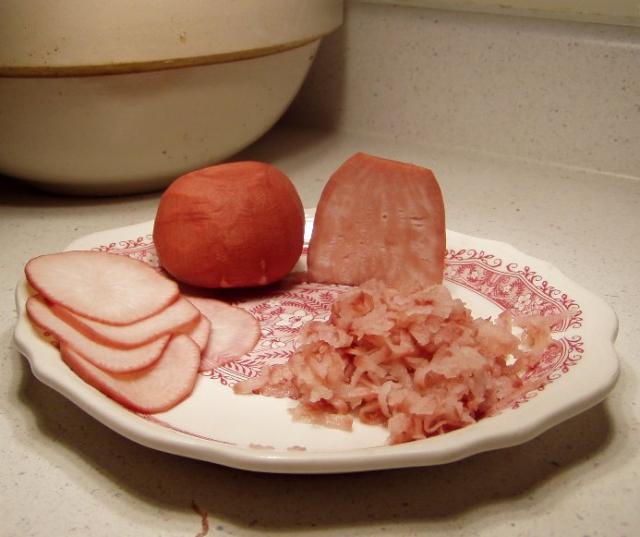
The turnips were very tangy, though you can see from the photos that the vinegar hasn't completely penetrated to the interior.
The brovada three ways: Raw, sauteed with garlic and sausage, and in Jota.
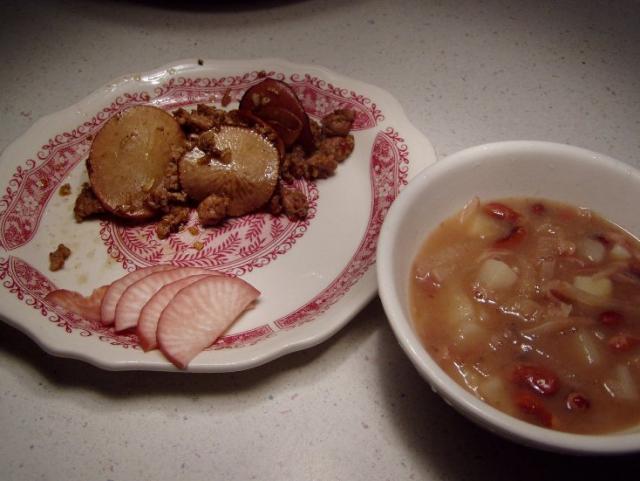
Raw, it tastes like turnip and vinegar. Sauteed with sausage, it's divine. The jota was quite good this time as well. I used cornfour to thicken it this time.
Here's a quick mention of some interesting recipes from the Friuli cookbook (I really wish that I'd had it at the beginning of this month!)
Bread--there aren't alot of recipes for bread, and the directions are sketchy for most of them. Many of the recipes are just proportions of ingredients, without time or temperature suggestions. One is called Hausproat, which is a mixture of buckwheat and corn flours, with yeast, water and salt. I'll bet it makes a dense loaf. There are also recipes for French bread, potato bread, a "focaccia" with eggs and cornflour, and Pan de Frizzis, which reminds me of eggy American biscuits, as it calls for 6 eggs in the batter and either pork cracklings or lardo.
There are several recipes for cavallo, guinea hen, and frog, and eight recipes for cjalsons, each named after the town of origin. There are a few recipes for an herb called "sculpit". I can buy seed for it from several different gardening catalogs, but I never knew how it was used. There is also a recipe titled "Suf which sounds suspiciously like the bechamel soup Kevin mentioned.
Whew! Sorry for such a long post. Now, on to Lazio.
April
-
Wish I'd heard about struccolo earlier in the month; I'd like to try one out myself, too. So was it just puff pastry dough?
What's really odd is that there's a baked version of the struccolo with the same ingredients (maybe a little chocolate and grappa thrown in, too) called gubana, served as a dessert . . .
No, my version was essentially pasta dough--flour, eggs, and water. The recipe was actually listed under the Primo/Pasta Fresca section of the cookbook. But, to get really confusing, Lidia's version of gubana does use puff pastry. Carol Field's version uses yeast bread. And in Culinaria, there is a recipe for pinza, which uses the same filling, and an egg dough. The dough is rolled up, cut and baked like cinnamon rolls.
April
-
Question Authority, April.
Phew!!
Just after READING that, I intend to have a salad for dinner...with frico.
************
I have never seen anything like your boiled strucolo, unless it's Adam's (?) ricotto and spinach roll.
Did you like it?
(I'm sorry, but it kinda reminds me of Shar-Peis!!!)
After posting, I felt an urgent need to walk the dog so that I could burn some calories.
And yes, I was referring to Adam's spinach roll. The Friuli cookbook has several savory struccolo recipes, including one similar to Adam's. I did like the flavor, although I think that the boiling made the nuts in the filling taste blander than if it had been baked. The shar-pei wrinkles likely occured because I rolled out the pastry almost square, which made it quite long, and iit had to be coiled up in order to fit it into the pot.
-
Last night, I finally found the time to cook a multi-course Friulian meal:
Antipasto: Strucolo Carsolino
Primo: Zuppa di Asparagi
Secondo: Pollo in Sguazet con Polenta
Contorno: "Spinaci" Affogata
Kevin wasn't sure if he broke any rules with his meal, but I know that I did. Lidia Bastianich states firmly in La Cucina di Lidia that the affogata isn't appropriate to serve with braised meats. I'm such a rebel.
The Strucolo:
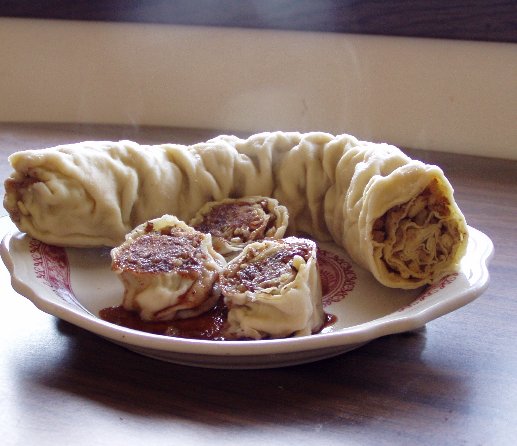
Everything else:
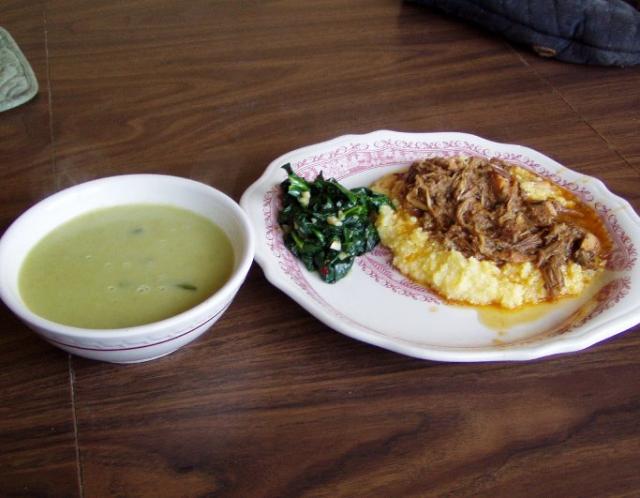
I was intrigued by all of the recipes for strucolo (also called rottolo upthread) that I found in my latest cookbook. The fact that most are to be boiled was also intriguing. In my own personal food classification system, I had always thought of strudels as being more akin to puff pastry. This was definitely more like a gigantic noodle, and I wish that I would have stretched the dough more, because cooked pasta was a bit thick in spots after cooking. I chose this particular recipe because the filling contains fried breadcumbs, nuts and raisins and the sauce has cinnamon and sugar in it. This combination seems to be a defining part of Friulian cuisine.
The asparagus soup was boiled asparagus pureed in its own cooking liquid and thickened with flour, butter and eggs. It was tasty, but very rich.
The affogato was based on a recipe from Lidia's book, I just substituted spinach for the escarole.
The main dish was mainly inspired by a dish that Lidia's co-author wrote about at the beginning of her book. The sauce was made from a long-simmerd free-range bird and served over fuzi. I don't see how the recipe actually given in the book on p.164 could even be compared, as the chicken is only simmered for 20 minutes.
This will probably seal my image as a knife-wielding maniac, but I had an old, tough, free-range rooster out in my barnyard. So, into the pot he went. I used the ingredients given in the recipe, but added extra stock and wine, and then simmered it all for over four hours. It was every bit as good as promised. Actually, I made the sauce on Sunday, and the leftovers have kept improving. My husband has been making sandwiches with the meat for his lunches.
After that, I needed a nap!
April
-
I've never mastered roasting a goose whole, either.
Not sure anyone really has actually. Ever read Steingarten's "Supergoose" article in his "Must've been something I ate" book? He tries every trick under the sun with many geese and never could manage to roast a perfect goose, with medium done breast, tender legs and crispy skin.
I'm glad to know that it's not just me, but it makes me wonder how roast goose was ever popular. Or maybe the modern varieties just aren't suitable for roasting.
April
-
All right, I should've specified "city boy" American-ness then.
 Please don't cut my head off!
Please don't cut my head off! I still want to hear about this brovada jota!
Sorry! I promise to be nice! Hey--I have until Friday to roll out the brovada. I will make the soup, never fear.
April
-
You raise and kill your own poultry, if memory serves me correct, no?
Yes, several kinds. One features in the dish that I cooked last night.
It's interesting that I found the same recipe for the haivar sauce on a number of French Web sites---the same thing happened when I looked for Hathor's genepi/y, although I suspect there are other factors involved in these two cases.What does "haivar" mean, anyone?
Sioux Falls, SD has a small Eastern European grocery. They carry about eight brands of ajver/ajvar (pronounced EYE-var) from various countries. Some have eggplant, and some do not. Each brand comes in Mild and Hot, although the Hot versions aren't truly hot, at least not for me.
I found a link on wikipedia discussing the word: Ajvar (from Turkish hayvar, salted roe)
(ETA: I see Adam already discussed this, but I didn't read far enough ahead before posting!)
I never managed to get a copy of Plotkin's book, but just last week my copy of La Cucina Del Friuli-Venezia Giulia in 850 Ricette Tradizionali arrived in the mail. Despite the large number of recipes, haivar isn't mentioned.
Red bell peppers are $1 apiece! right now, so homemade haivar is on my list.
April
-
Let me roll out my complete American-ness here and say that those ducks and geese at the Asian markets scare me since they still have the heads on. Which leads me to worry that they may not be gutted, either. Besides, I don't have anything I could readily hack their heads off with.
Um, this American deals with whole poultry all the time.
 I haven't purchased any type of bird at the supermarket since I moved to the country eight years ago. But, heads don't need to be hacked off. You can disjoint the neck by cutting between two vertebrae close to the body. Gutting isn't fun, but not difficult either--pm if you ever want details.
I haven't purchased any type of bird at the supermarket since I moved to the country eight years ago. But, heads don't need to be hacked off. You can disjoint the neck by cutting between two vertebrae close to the body. Gutting isn't fun, but not difficult either--pm if you ever want details. I've never mastered roasting a goose whole, either.
Did you make your own haivar sauce? I buy it all the time here, and I wish that I'd realized that it was part of Friulian cusine.
Off to make a Friulian dinner!
April
-
I'm also looking forward to hearing more about April's fermenting turnips.
I'm not sure that they're actually fermenting, thought they are nice and pink. I'm not seeing any bubbling that would indicate fermentation. Probably it would happen if I ever remember to add grape must. I plan on using them for a meal this weekend, and I still am planning on using the turnips to make another batch of jota before the end of the month. Right now I have a version of Chicken in Sguazet, inspired by a story in La Cucina di Lidia simmering away in my crockpot overnight. I'll report on it tomorrow.
April
-
Hathor, welcome back! What a great trip report. Thanks for sharing your adventures with us. Can you tell us more about the ingredients in the coniglio humido? And I'm really curious about the seeming popularity of horse steaks. Is there a local breed raised just for meat?
April
-
Why not use something in season, or even better use, say soaked and cooked dried butter beans (which are Fava beans in their winter guise)
Over here, butter beans are a type of lima bean. I've never seen favas labelled as such.
April
-
I'm still interested, and Library Thing does look promising to me.
There is also a place for adding reviews which is where the person entering the book would be able to offer a synopsis or helpful comments, especially about books that are no longer in print and therefore not linked to summaries provided by Amazon.com.What I have not yet established is if Library Thing provides a means for organizing entries in subject categories or by author or date.
The book list can be grouped by Author, Title, Date, or Tag simply by clicking on the word at the top of each column. For example, if you click on "Author", the book list is then sorted alphabetically by author. The "Tag" column is where we would designate subjects and provide other pertinent information, such as the publisher, regions, and the location/owner(s) of the book.
From Library Thing:
What are tags? (short answer)Tags are a simple way to categorize books according to how you think of them, not how some library official does. Anything can be a tag—just type words or phrases, separated by commas. Thus one person will tag the The DaVinci Code "novels" while another tags it "trashy, religion, mary," and still another only "summer home." Tags are particularly useful for searching and sorting—when you need a list of all your novels or all the books at the summer home.
I had missed silverbrow's link, so I need to go look at that, and then compare the two.
April
-
The leaves of the California Bay Laurel are also sold as "bay leaves", though the flavor is slightly different from European Bay.
I like to add roasted red pepper strips to bean soups. They add a tangy sweetness. I think of beans as the plain, starchy base of the soup. Potato or barley soup would be bland without other ingredients as well. The excitment comes from what you add!
April
-
Batali's grapes are there as a nod to the grape must traditionally used to ferment the turnips, of course, as either you or Ludja mentioned earlier in the thread. His versions of brovada and mostarda di Cremona [the recipe in Molto Italiano differs from the one online, FYI] remind me that as much as we have access to so many ingredients not imported a couple of decades ago, it's still necessary to make a few adjustments.
I look forward to hearing about the results of your venture. I had no idea the turnips are left whole and not grated first.
P.S. I found a copy of Waverly Root's "Foods of Italy" from the Time-Life series recently. Writing in th 60's, he says that families in Friuli still bake their own bread at home.
Batali's on-line recipe only calls for two days of fermenting, hence the need smaller pieces. He probably doesn't want to wait two months to use it. My on-line sources mention grating or thinly slicing the turnips just before use. My turnips have already softened and are now red all the way through. It will be interesting to see how the flavor and texture changes over time. Has anyone here had the original version?
Does Waverly Root mention what kinds of bread were baked in Friuli? I haven't been able to locate any mention of wheat- or rye-base unsweetened breads. How much wheat is grown in Friuli?
April
-
Nathan--Wow! I think that you have Kevin beat for access to coolest ingredients (outside of Italy). San Daniele ham, Mantasio cheese, and Tocai wine! Sigh. I don't think anybody has heard of Friuli around here.
Everyone is full a few fricos ago but it would be a sin to waist the leftover mushrooms ($20/lb) so one more frico with onions, mushrooms and potato.Heh--I imagine that's where all of the fricos were headed anyway. I feel the need to go for a run after just looking at your luscious photos.
This must be the coolest cooking pun ever:
Let your Frico flag flyApril
-
Tonight I started a batch of brovada. Here's the "before" shot:
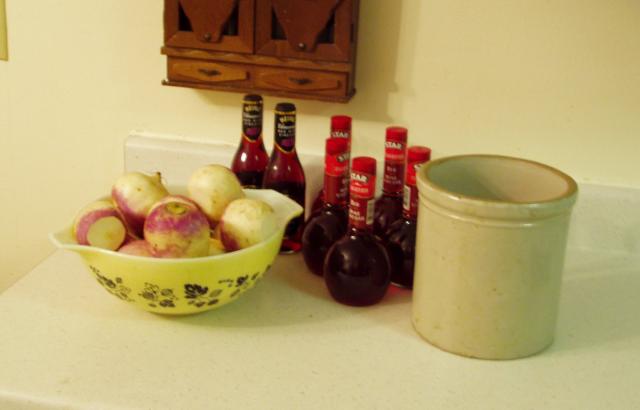
And here are the turnips steeping in the red wine vinegar:
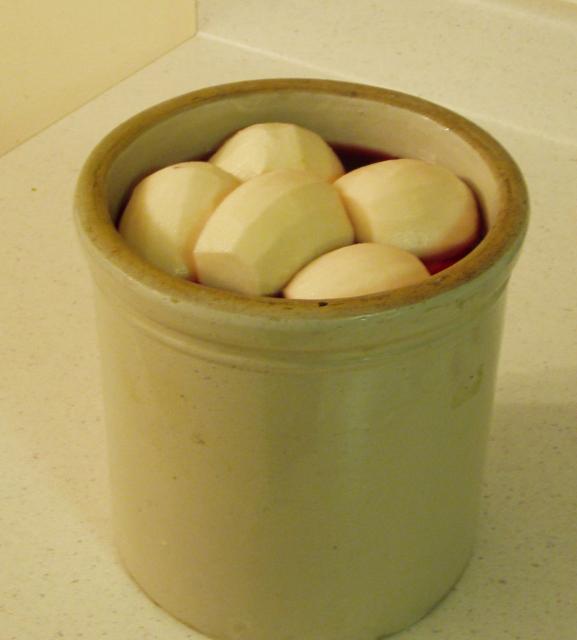
Not pictured: a bowl and a weight to keep the turnips under the liquid.
After following the links provided upthread to Mario Batali's site, I see that he adds crushed red grapes to his version. I think that I might add some, in the hope that it might add to the flavor of the finished pickle.
Ideally, the tunips should ferment at least 20 days, but my plan is to use some of them by the end of the month to make another batch of jota.
I've been thinking about why the jota that I made was so appealing to me. The soup was tasty on its own merits, but it really reminded me of something that I'd had before. I finally remembered a dish that my parents made frequently when I was young that we called "Hot German Potato Salad". I don't know if this is made in Germany. Potatoes were boiled whole, then peeled and diced and added to a sauce containing mainly bacon, vinegar and celery. I swear that this tastes just like jota. In a way, my culinary wanderings have brought me home. I'm eager to prepare this soup for my Mom to see what her reaction is.
April



The Cooking and Cuisine of Lazio
in Italy: Cooking & Baking
Posted
They are larger, and they taste "richer" to me, though my chicken eggs are "richer" than store-bought ones, so it could just be due to diet.
The turkey eggs act "drier" when used in baking, as the yolk is thicker, and smaller in proportion to the white when compared to chicken eggs. The whites are tougher if you hard-boil them. I need to revisit the Val d'Aosta thread now that I have so many eggs!
April